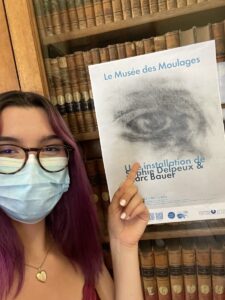This Tuesday, June 7th, we had the opportunity to visit the Musee de Moulages at the Hospital Saint-Louis. The museum houses “a unique collection of wax dermatological models”, as coined by the subtitle on the front cover of the museum pamphlet.

Reflecting upon my visit, I can concur that this museum has a unique collection indeed. With collections of wax models displaying pathologies such as syphilis, tuberculosis, eczema, acne, elephantiasis, tumors, and much more, the museum leaves a lasting impression.


The first week of the program, we learned about the “gut-brain axis” with the first target article. Upon visiting the dermatology museum, I began to wonder if the same kind of connection exists between the brain and the skin, a “skin-brain axis”. Considering that the skin is the largest organ in the body, I postulated that this connection must exist in some form or another. Before diving into the current scientific literature, I speculated on different relationships that might exist between the brain and the skin: How do neurological variables such as stress manifest in the skin? How does skin pathology affect the brain? What kinds of information does the skin communicate to the brain and through what mechanisms?
I found that the “brain-skin” connection does exist, and lends itself to a great intersection of research involving different fields of study such as psychology, neurobiology, dermatology, immunology, etc. Stress and skin conditions have been known to be associated for centuries, and modern research has established the existence of a causal relationship as psychological stress can lead to the onset and/or aggravation of multiple skin diseases. Many studies also reveal that stress accelerates skin aging (Lee et al., 2020; Rinnerthaler et al., 2015) and exacerbates skin inflammation (Chen et al., 2014). Not surprisingly, anxiety has been proven to increase susceptibility to skin diseases which one study claims is due to the disruption of cutaneous homeostasis via prolonged sympathetic nervous system activation (Öksüz et al., 2020). In addition, the relationship between depression and chronic wounds has been investigated as these conditions often have a high comorbidity (Hadian et al., 2020).
However, in my opinion, the most interesting finding of my literature review of the skin-brain axis concerned the affective function of the skin. The discriminative properties of the skin have been well identified, however, the discovery of a new class of nerve fiber, unmyelinated C-fiber afferents, has led to a new understanding of skin function as a coder of emotional touch. C-tactile mediated touch such as massage therapy has exciting implications for clinical treatments of both physical and psychological symptoms of chronic skin conditions like eczema.
All in all, neuroscience is a wonderfully interdisciplinary subject that has interesting implications on nearly all areas of biology and different clinical practices – including dermatology!
Chen, Y., & Lyga, J. (2014). Brain-skin connection: stress, inflammation and skin aging. Inflammation & allergy drug targets, 13(3), 177–190. https://doi.org/10.2174/1871528113666140522104422
Hadian, Y., Fregoso, D., Nguyen, C., Bagood, M. D., Dahle, S. E., Gareau, M. G., & Isseroff, R. R. (2020). Microbiome-skin-brain axis: A novel paradigm for cutaneous wounds. Wound repair and regeneration : official publication of the Wound Healing Society [and] the European Tissue Repair Society, 28(3), 282–292. https://doi.org/10.1111/wrr.12800
Lee, C. M., Watson, R., & Kleyn, C. E. (2020). The impact of perceived stress on skin ageing. Journal of the European Academy of Dermatology and Venereology : JEADV, 34(1), 54–58. https://doi.org/10.1111/jdv.15865
Lloyd, D. M., McGlone, F. P., & Yosipovitch, G. (2015). Somatosensory pleasure circuit: from skin to brain and back. Experimental dermatology, 24(5), 321–324. https://doi.org/10.1111/exd.12639
Öksüz, Ö., Günver, G., Oba, M. Ç., & Arıkan, K. (2020). Psychiatry to dermatology; panic disorder. Journal of clinical neuroscience : official journal of the Neurosurgical Society of Australasia, 81, 316–320. https://doi.org/10.1016/j.jocn.2020.09.071
Rinnerthaler, M., Bischof, J., Streubel, M. K., Trost, A., & Richter, K. (2015). Oxidative stress in aging human skin. Biomolecules, 5(2), 545–589. https://doi.org/10.3390/biom5020545
